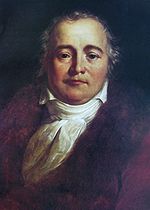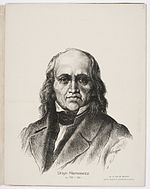- Julian Ursyn Niemcewicz
-
Julian Ursyn Niemcewicz (Skoki, near Brześć, February 6, 1758 – May 21, 1841, Paris) was a Polish poet, playwright and statesman. He was a leading advocate for the Constitution of May 3, 1791.
Contents
Life
Niemcewicz, scion of a moderately well-to-do Polish noble family, graduated from the Warsaw Corps of Cadets.
He subsequently served as aide to Adam Kazimierz Czartoryski and visited France, England and Italy.
During the Great Sejm of 1788–92, Niemcewicz was a deputy and an active member of the Patriotic Party that pushed through the historic Constitution of May 3, 1791. He subsequently was a founder of the Zgromadzenie Przyjaciół Konstytucji Rządowej (Assembly of Friends of the Government Constitution), formed to help support and implement that progressive document.
After the victory of the Targowica Confederation in 1792 and the consequent overthrow of the May 3 Constitution, Niemcewicz, along with other Patriotic Party members, emigrated to Germany.
During the Kościuszko Uprising (1795), Niemcewicz served as aide to Tadeusz Kościuszko. Both were captured by the Russians at the Battle of Maciejowice (1794) and imprisoned in the Peter and Paul Fortress at St. Petersburg. In 1795 they were released by Tsar Paul I of Russia and made their way together to the United States, where Niemcewicz married. He was disconsolate when Kościuszko subsequently decamped for Europe without giving him any notice.[1]
After the Congress of Vienna, Niemcewicz was secretary of state and president of the constitutional committee in Poland.
On 11 May 1830 he unveiled a new landmark before the Staszic Palace, the seat of the Society of Friends of Science in Warsaw — a monument to Nicolaus Copernicus sculpted by Bertel Thorvaldsen.
During the failed November Uprising of 1830–31, Niemcewicz was a member of the insurrectionary Polish government. When the Russians suppressed the uprising, Niemcewicz was again forced into exile. He died in 1841 in Paris.
Writings
As a writer, Niemcewicz tried many styles of composition. His political comedy, The Return of the Deputy (1790), enjoyed great acclaim. His novel, John of Tenczyn (1825), written in the style of Sir Walter Scott, gives a vigorous picture of old Poland.
He also wrote a History of the Reign of Sigismund III (3 volumes, 1819) and a collection of memoirs for ancient Polish history (6 volumes, 1822-23).
But he is now best remembered for his Historical Songs of the Poles (Warsaw, 1816), a series of lyrical compositions whose main heroes hark back to the Golden Age of Sigismund I and to the reigns of Stefan Batory and Jan III Sobieski.
Niemcewicz's 1817 pamphlet Rok 3333 czyli sen niesłychany (The Year 3333, or an Incredible Dream), first published posthumously in 1858, describes a Poland transformed into a sinister Judeo-Polonia. The pamphlet has been described as "the first Polish work to develop on a large scale the concept of an organized Jewish conspiracy directly threatening the existing social structure."[2]
His collected works were published in 12 volumes at Leipzig in 1838-40.
Works
- Władysław pod Warną (Władysław at Varna, 1788)
- Kazimierz Wielki (Kazimierz the Great, 1792)
- Powrót posła (The Return of the Deputy, 1791)
- Na hersztów targowieckich (The Targowica Chiefs)
- Podróże historyczne po ziemiach polskich (Historic Travels over the Polish Lands)
- Śpiewy historyczne (Historic Songs)
- Dzieje panowania Zygmunta III (A History of the Reign of Zygmunt III)
See also
Notes
- ^ Niemcewicz, Under Your Vine and Fig Tree.
- ^ Magdalena Opalski, Israel Bartal, Poles and Jews: A Failed Brotherhood, University Press of New England, 1992.
References
- Julian Ursyn Niemcewicz, Under Your Vine and Fig Tree, Mechie J. Budka, editor.
 This article incorporates text from a publication now in the public domain: Chisholm, Hugh, ed (1911). Encyclopædia Britannica (11th ed.). Cambridge University Press.
This article incorporates text from a publication now in the public domain: Chisholm, Hugh, ed (1911). Encyclopædia Britannica (11th ed.). Cambridge University Press.
Figures in the Age of Enlightenment by country or region Notable figures America (English) America (Latin) England Edward Gibbon · Thomas Hobbes · Samuel Johnson · Edmund Burke (Irish born) · John Locke · Isaac Newton · Robert WalpoleFrance Germany Greece Hungary Italy Low Countries Poland-Lithuania Stanisław Konarski · Ignacy Krasicki · Hugo Kołłątaj · Stanisław Staszic · Jan Śniadecki · Julian Ursyn Niemcewicz · Jędrzej ŚniadeckiPortugal Romanian States Russia Scandinavia Scotland Serbia Spain Ukraine Related topics Categories:- 1757 births
- 1841 deaths
- Members of the Great Sejm
- Polish writers
- Polish nobility
- Kościuszko insurgents
- Polish diplomats of November Uprising
- Activists of the Great Emigration
- Polish dramatists and playwrights
- Members of Polish government (November Uprising)
- Recipients of the Order of Saint Stanislaus
Wikimedia Foundation. 2010.




